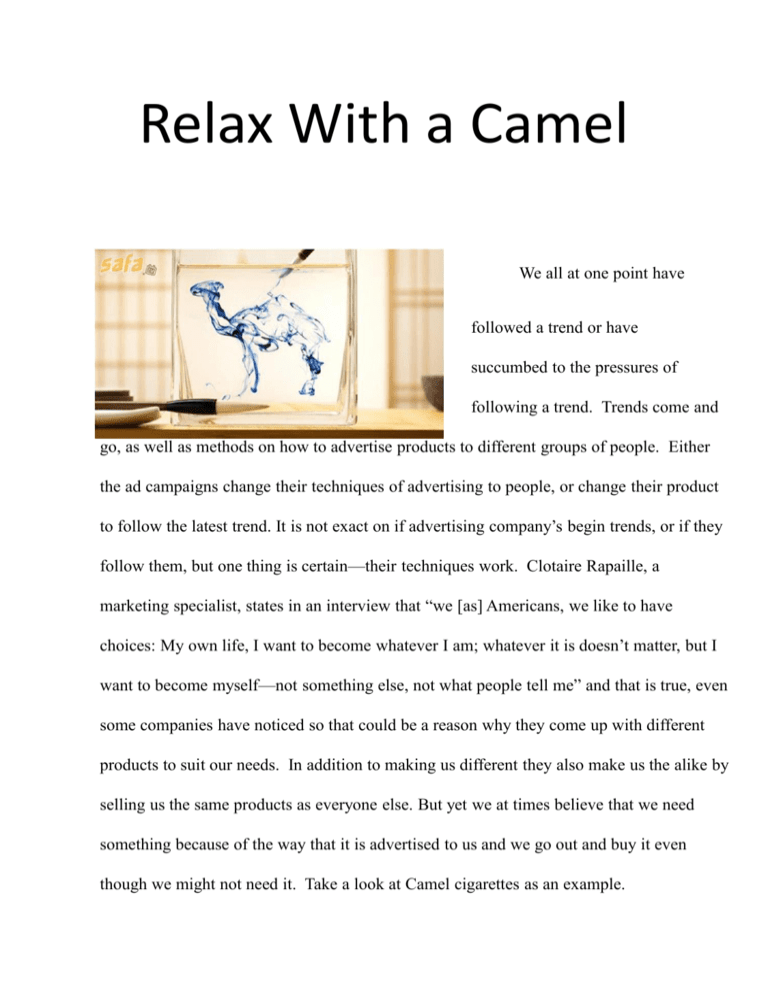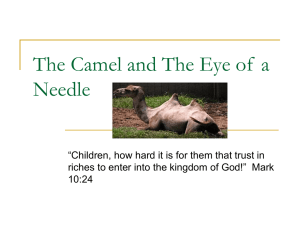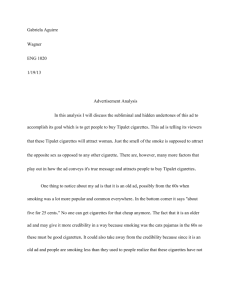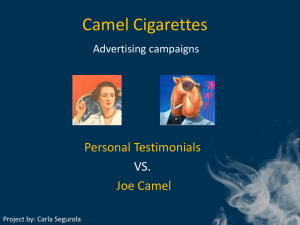Relax With a Camel - throughconsumerseyes
advertisement

Relax With a Camel We all at one point have followed a trend or have succumbed to the pressures of following a trend. Trends come and go, as well as methods on how to advertise products to different groups of people. Either the ad campaigns change their techniques of advertising to people, or change their product to follow the latest trend. It is not exact on if advertising company’s begin trends, or if they follow them, but one thing is certain—their techniques work. Clotaire Rapaille, a marketing specialist, states in an interview that “we [as] Americans, we like to have choices: My own life, I want to become whatever I am; whatever it is doesn’t matter, but I want to become myself—not something else, not what people tell me” and that is true, even some companies have noticed so that could be a reason why they come up with different products to suit our needs. In addition to making us different they also make us the alike by selling us the same products as everyone else. But yet we at times believe that we need something because of the way that it is advertised to us and we go out and buy it even though we might not need it. Take a look at Camel cigarettes as an example. Men have been the focus in the ads throughout the decades. If we go to the nineteen thirties we can see that they used men in sports as a way to advertise the cigarettes as a stimulant proclaiming that they gave them energy. If we go one decade ahead into the nineteen forties we see the Camel cigarette ads had begun to get patriotic during World War II. The way they advertised the cigarettes then, is by proclaiming that the marines, navy and army men preferred Camel cigarettes. You would want to support your country, wouldn’t you? While America was entering World War II the ads switched its theme to patriotism. They began to tell a story of families sending their sons, fathers, and even husbands packs of Camel cigarettes as a way to show that they supported them during the war. In one ad it said “It’s the most welcome gift you can send him…a carton of Camels- the soldier’s favorite”. Soldiers smiling, soldiers reading, they had received a letter and a pack of Camel Cigarettes. It was a good technique used by the company to advertise their product according to what was going on in the world as well as suggesting that they made the soldiers happy. In the nineteen fifties they began to use actors to promote Camel cigarettes. Some of the men in these ads included Robert Young, Rick Hudson, Tony Curtis, and Phil Silvers. John Wayne and Brian Keith whom also starred in Camel ads later died from lung and stomach cancer, and emphysema. In the seventies the “Camel Man” appears, “Camels finally decides maybe it’s not the filter, as much as the tough guy image. So they introduce their own ‘Camel Man’. In every ad, a different woman is staring at him.” Sadly the “Camel Man” didn’t stick around for too long and in the early nineteen eighties a new man appears and they cut out woman from the advertisements and a new slogan appears “It’s a whole new world”, and “Where a Man Belongs”. Although men have been the focus in the Camel ads they have faded in and out of them. There has also been another person that has contributed to the message that the Camel’s cigarette ads have tried to express. When the men in the ads were the biggest picture the reader could see, there has been an attractive woman in the back ground to suggest that all eyes would be on the man that smokes a Camel cigarette. It would be safe to say that he is a man who loves Camel cigarettes, and who has all eyes on him. “By the end of the decade [1920], Camel is pursuing young female customers. They suggest that in between their tea parties and gold, classy rich women would appreciate Camel Cigarettes.” Camel cigarettes began to advertise women who showed class and sophistication by putting drawings of charming women. Men and women are not the only targets of advertisements. Every ad campaign tries new things so they can attract different audiences like trying to target younger people to begin smoking at a younger age, or at least that’s how it’s interpreted. Pediatricians had conducted a survey with teens throughout four years. According to John Bonifield a CNN Medical Producer, “in [a] study, girls were asked over the course of several years, ‘What is the name of the cigarette brand of your favorite cigarette advertisement?’ In 2004, 10 percent of girls chose Camel as their favorite brand. In 2008, a year after R.J. Reynolds launched its new campaign, nearly 22 percent of girls chose Camel as their favorite brand.” Although this ad was “featured in popular women’s magazines like Glamour, Lucky and Vogue back in 2007”, some people believed that it was targeting teenage girls because “the cigarettes are featured right alongside a beautiful dress, shoes, jewelry, and a purse- the kinds of items that you might expect teen girls to find glamorous and appealing.” Although it seems that the ad was targeting teenage girls, “the company’s statement goes on to say, ‘Camel No. 9 was developed in response to female adult smokers… who were asking for a product that better reflected their taste preferences and style.’” In the late 1980’s Camel cigarettes tried a new way to advertise their product, but was it a good move for the company? Some people believed that their new tactic of using Camel Joe to advertise their cigarettes was a bad move because it also appealed to younger children. Giving energy, was what Camel cigarettes was saying that it gave people as well as helping them get through the day. . The ads began to feature people doing sports and being active to prove their point. Later in the 1950’s they began to say that they helped people relax. The company came up with the slogan that was found in every ad “No other cigarette so rich-tasting yet so mild as camel”, and had their models lean back as to show how relaxing smoking a camel would make you. As decades came and went the focus of the ads changed drastically; from advertising to men and making it a manly cigarette to making women the focus and having them advertise the sophistication and class that a Camel cigarette gave a woman. What’s really intriguing is the statement that the cigarettes would give a person energy and then a decade later proclaim something totally different- that it was a downer and relaxed a person. Surprisingly I found an article almost stating the exact same thing that an ad from the 1940’s stated, “Smokers often say that lighting up a cigarette can calm their nerves, satisfy their cravings, and help them feel energized.” In a survey found in “The Psychology of Everyday Living” by Ernest Dichter “there are several reasons why a person feels good when smoking a cigarette, among one of them is the reeling of being relaxed. It has nothing with a substance in the cigarette alone, it’s just stated that some people just feel relaxed because it’s an effortless activity to just sit back and relax while they watch the smoke be released from their nostrils or mouth.” According to GumAuctions.com it stated that “for those born prior to the passage of the Public Health Cigarette Smoking Act in 1970, there was an overwhelming amount of false information [such as] ads implied smoking could make one more attractive or wealthy, advertisements promoted the health benefits of smoking, physicians even touted the health benefits of smoking, [and] family and friends encouraging smoking.” There are different reasons for teens though, “in teens, peer pressure is generally the major factor in starting to smoke. Anecdotes from friends or esteemed peers can counteract their knowledge of the damage smoking can do. Some things teens thing about when deciding to smoke are: it looks cool- an image perpetuated by cigarette use in pop culture, it will keep you from eating and help you lose weight, cigarettes will help you think and make homework easier, smoking helps you relax, [and] they don’t know anyone who has died from smoking.” Cigarette companies have been targeting many people to get them to buy their product. In the book Brave New World Revisited it states “Hyde is a motivation analyst, and his business is to study human weaknesses and failings, to investigate those unconscious desires and fears by which so much of men’s conscious thinking and overt doing is determined. And he does this, not in the spirit of the moralist who would like to make people better, or of the physician who would like to improve their health, but simply in order to find out the best way to take advantage of their ignorance and to exploit their irrationality for the pecuniary benefit of his employers. But after all, it may be argued, “capitalism is dead, consumerism is king”- and consumerism requires the service of expert salesman versed in all the arts (including the more insidious arts) of persuasion” (278). They get us hooked with the additives in the tobacco and makes us unable to stop smoking and making it addictive. Although they have stated that they don’t target young children they make it hard for is to see that because the ads have gave us results that they do and that it’s working. Works Cited Bonifield, John. "Was It a Cigarette Ad Campaign That Worked – on Teenagers? – The Chart CNN.com Blogs." The Chart - CNN.com Blogs. 15 Mar. 2010. Web. 27 Apr. 2011. <http://thechart.blogs.cnn.com/2010/03/15/was-it-acigarette-ad-campaign-that-worked-onteenagers/?hpt=T2/>. Dichter, Ernest. "Why Do We Smoke Cigarettes." Smoking Sides. Web. 23 Apr. 2011. <http://smokingsides.com/docs/whysmoke.html>. Huxley, Aldous, and Aldous Huxley. "THE ART OF SELLING." Brave New World: And, Brave New World Revisited. New York: HarperCollins, 2004. 27786. Print. Rapaille, Clotaire. "Frontline: "The Persuaders"" Frontline: "The Persuaders" Television. Unknown. "Camel Cigarette Advertising 1930s." Indy Motor Speedway. Web. 01 May 2011. <http://indymotorspeedway.com/cigs/1930s.html>. Unknown. "Why Do People Smoke Cigarettes." Gum Auctions. Nicorette Gum. Web. 01 May 2011. <http://www.gumauctions.com/article/155/Why-DoPeople-Smoke-Cigarettes/>.





